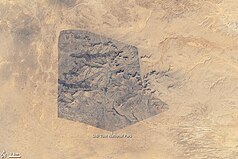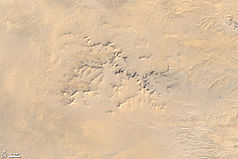Sidi Toui National Park
| Sidi Toui National Park | ||
|---|---|---|
| Satellite image, 1999. Only in the park area has the original grassy landscape been restored by reducing overgrazing. | ||
|
|
||
| Location: | Tunisia | |
| Next city: | Ben Gardane | |
| Surface: | 63.15 km² | |
| Founding: | 1991 | |
| The park area 1987 | ||
The Sidi Toui National Park (Arabic: المحمية الوطنية بسيدي الطوي) is a national park in southern Tunisia , 20 km from the border with Libya , about 50 km south of Ben Gardane . It has existed since 1991 and the animal and plant populations have recovered significantly since then.
Geography, landscape
The protected area extends over an area of 6,315 hectares and is surrounded all around by the sand of the Sahara . The annual rainfall is between 100 and 150 mm; the lowest temperatures are at 5 ° C, the highest at 38, the peak at 50 ° C. There are no bodies of water in the area, apart from a single water point. Most of the birds gather there.
Steppe and dune areas are characteristic, the highest mountain, the Djebel Sidi Toui, rises to a height of 172 m above sea level.
Flora and fauna
White wormwood ( Artemisia herba-alba ) is the most common plant species in the arid area, plus Rhanterium, which, like wormwood, belongs to the daisy family (Asteraceae) and also occurs on the north side of Djebel Sidi Toui. There you will also find Haloxylon scoparium (French: saligne à balai) and coloquinte .
The fauna is often under protection, such as oryx , golden jackal ( Canis aureus ), rüppellfuchs , black cat and fennec . In addition, there are reptile species such as the thorntail agamas , but also the common chameleon and various snakes . The desert monitor , agamen, or the wall gecko ( Tarentola mauritanica ) can also be found. The national park is one of 13 areas in Tunisia in which antelopes occur.
Some migratory birds from the Kneïes Islands from southeast of Sfax must make a stop, but there are also resident species such as Houbara Bustard , Barbary Partridge , grouse , raven and Rennvogel .
Argiope lobata from the genus Argiope , spiders from the family of the real orb web spiders , Sparrasus dufouri (French: araignée du désert) or the venomous southern black widow can be found on spiders .
history
The park used to be visited by ostriches and hartebeest , the latter still found in 1912 between Dahibah and Hamada al-Hamra in Libya. Both species are now considered extinct in Tunisia. The subspecies North African hartebeest ( Alcelaphus buselaphus subsp. Buselaphus ) was exterminated by intensive hunting around 1900; Plans to reintroduce the subspecies Alcelaphus buselaphus major have not yet been carried out. Seven European zoos agreed to release gazelles from their stocks in the national park, as well as in two other parks in Mali and Niger . The Cuvier gazelle ( Gazella cuvieri ) was still found in four areas of Tunisia at that time, including in the Sidi Toui Park. In 1999 10 or 14 saber antelopes ( Oryx dammah ) were released. Around 2000, 30 Dorcas gazelles ( Gazella dorcas ) were counted in the park, and individual animals were also registered outside the reserve.
The only human visitors to the park are a few pilgrims who go to the burial sites of some marabouts .
Web links
- Moncef Ben Salem: Faune et flore du parc national de Sidi Toui , in: La Presse de Tunisie , 4 August 2008
- TN045 Sidi Toui , BirdLife International
Remarks
- ↑ According to David P. Mallon, Steven Charles Kingswood: Antelopes. North Africa, the Middle East, and Asia , International Union for Conservation of Nature and Natural Resources, Gland / Cambridge 2001, p. 32 it was 6,135 ha.
- ^ David P. Mallon, Steven Charles Kingswood: Antelopes. North Africa, the Middle East, and Asia , IUCN, 2001, p. 30.
- ^ A World of Science. Natural Sciences Quarterly newsletter 5.4 (October-December 2007) p. 13.
- ↑ They came from six zoos in five countries, as ... indicates. Nine calves had been born by 2001 ( Environmental Governance Sourcebook , Bratislava 2003, p. 129).
- ↑ The figure comes from Natalie Goldstein: Earth Almanac. An Annual Geophysical Review of the State of the Planet , Oryx Press 2002, p. 359.
- ^ Sidi Toui National Park , United Nations Environment Program.
- ^ David P. Mallon, Steven Charles Kingswood: Antelopes. North Africa, the Middle East, and Asia , International Union for Conservation of Nature and Natural Resources, Gland / Cambridge 2001, p. 36.
- ↑ Didier Genin, Henri Guillaume, Mohammend Ouessar, Azalez Ouled Belgacem, Bruno Romagny, Monghi Sgaier, Houssine Taamallah: Entre Desertification et Developpement. La Jeffara tunisienne , Tunis 2006, p. 298.




